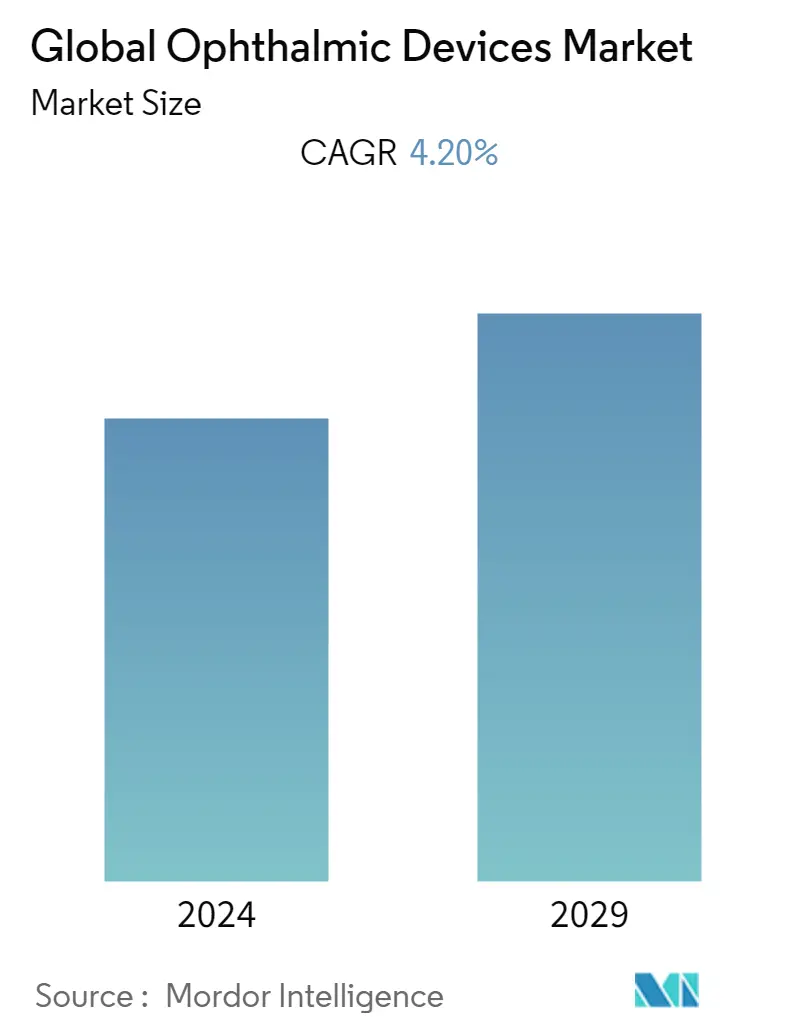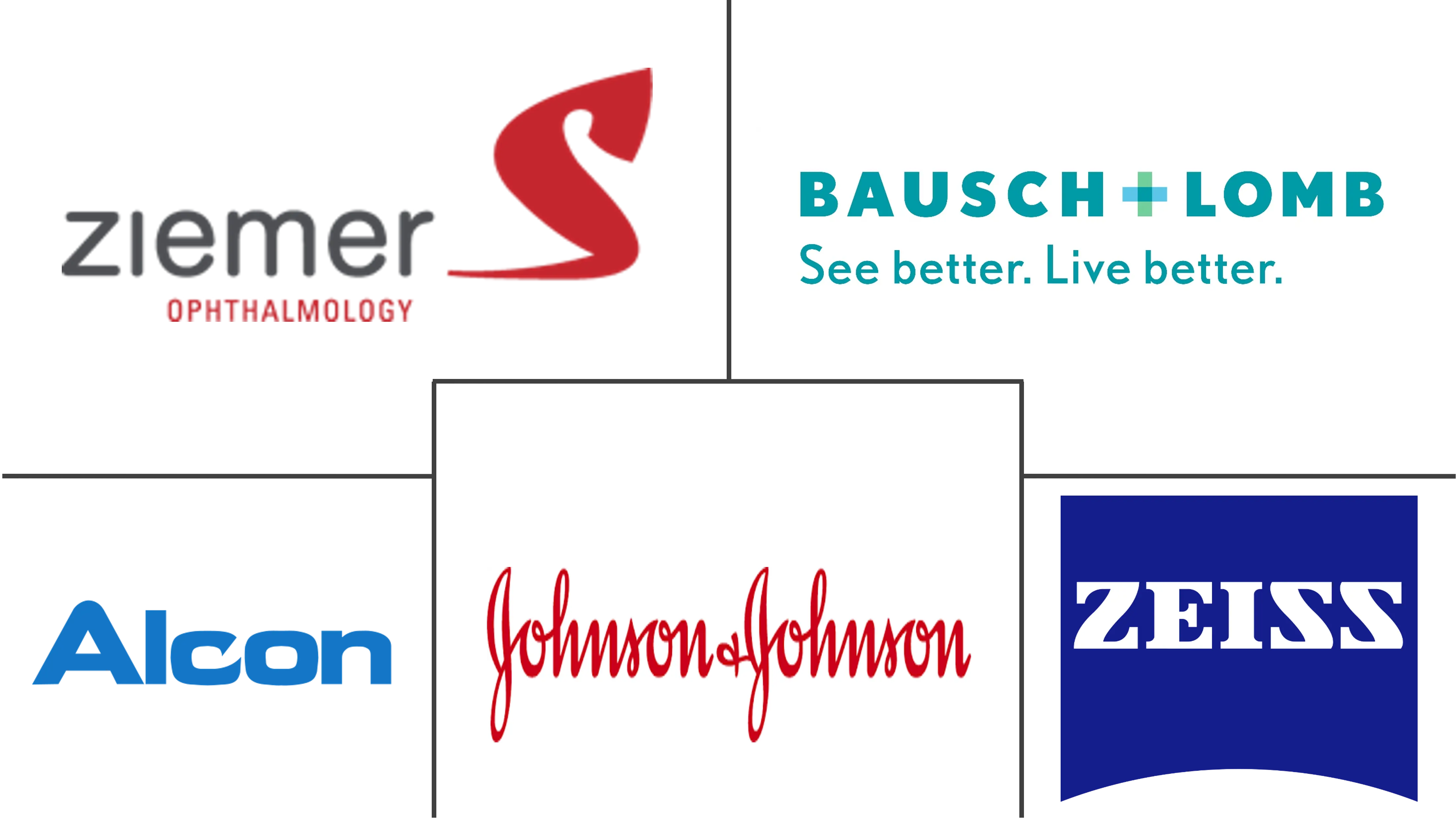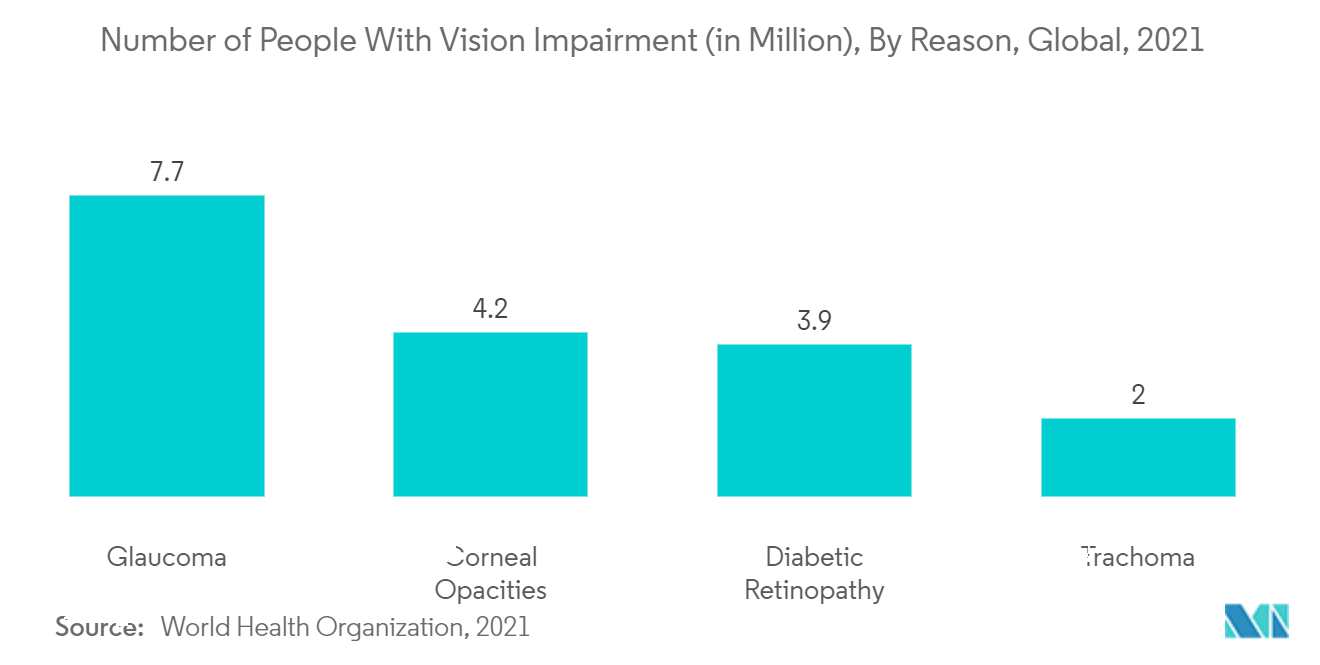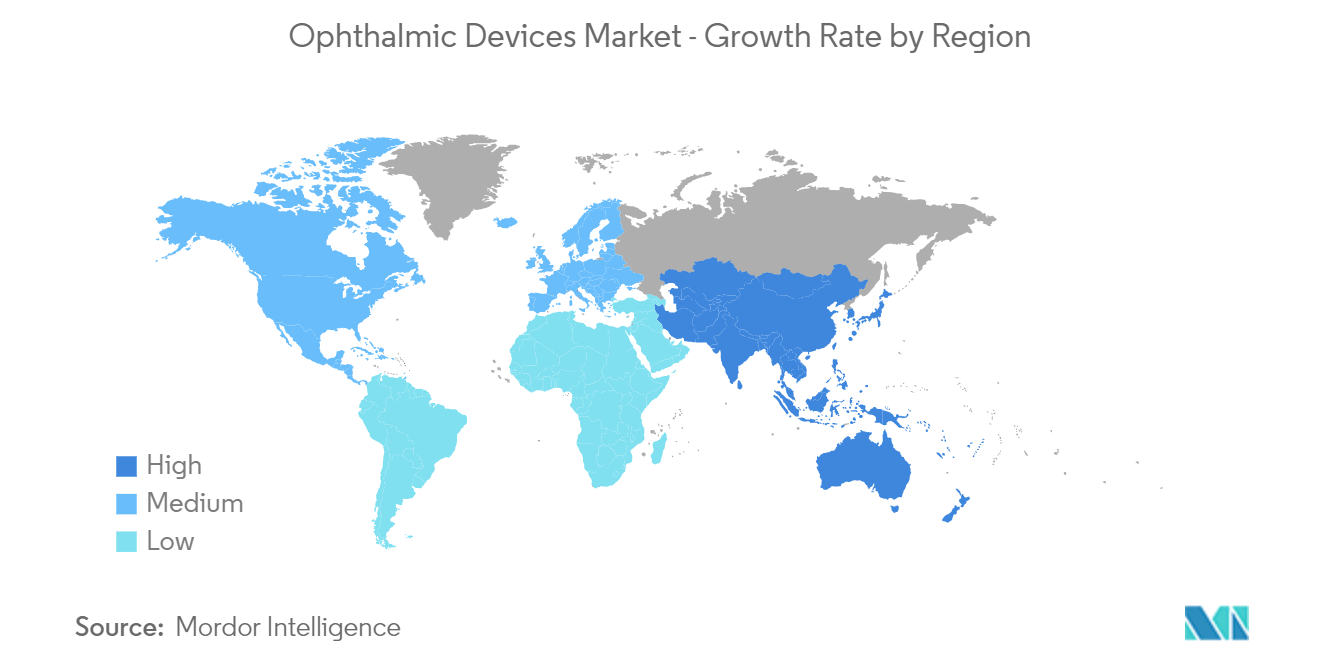Ophthalmic Devices Market Size

| Study Period | 2019 - 2029 |
| Base Year For Estimation | 2023 |
| CAGR | 4.20 % |
| Fastest Growing Market | Asia Pacific |
| Largest Market | North America |
| Market Concentration | Medium |
Major Players
*Disclaimer: Major Players sorted in no particular order |
Ophthalmic Devices Market Analysis
The ophthalmic devices market is projected to register a CAGR of 4.2% over the forecast period (2022-2027).
The COVID-19 epidemic has resulted in considerable service reductions throughout the NHS, with ophthalmology being one of the most severely impacted specialties. According to a study published in March 2021 titled "The Impact of the First Peak of the COVID-19 Pandemic on a Pediatric Ophthalmology Service in the United Kingdom: Experience from Alder Hey Children's Hospital," outpatient clinic appointments were reduced by 87.2%, ophthalmic surgery by 90.9%, outpatient referrals to ophthalmology by 50.2%, and ward reviews by 50% during the first peak of the pandemic. There were 1,377 canceled appointments, with 6.8% of them deemed appropriate for teleophthalmology. Another study titled "Modeling the Impact of COVID-19 on Retina Clinic Performance," released in May 2021, found that during the COVID-19 health emergency, retina clinic volume fell by 62%. The average time from check-in to technician has decreased by 79%, total visit length has decreased by 46%, and time spent in the provider phase of care has decreased by 53%. Thus, the COVID-19 pandemic severely curtailed ophthalmology service clinical activities, thereby impacting the market growth rate in its initial phase.
Furthermore, ophthalmic devices are medical equipment designed for diagnosis, surgical, and vision correction purposes. These devices have gained substantial importance due to the high prevalence of various ophthalmic diseases such as glaucoma, cataracts, and other vision-related issues across the globe. According to the World Health Organization, March 2022, update, trachoma is a public health problem in 44 countries and is responsible for the blindness or visual impairment of about 1.9 million people globally. It also reported that in 2020, 42,045 people received surgical treatment for the advanced stage of the disease. Such a high burden of disease and the need for surgical treatment is thus driving the growth of the market.
Moreover, technological advancements in the ophthalmology field have boosted the adoption rate of these devices globally. Portable medical devices are increasingly being used for home-based diagnosis and treatment of eye disorders, allowing for the diagnosis and monitoring of eye illnesses. For example, in May 2020, Icare USA released the Icare ic200 handheld tonometer for measuring intraocular pressure (IOP) on the go. There are no air puffs, anesthetic drops, or specific abilities required to assess IOP with this device. It can test patients while they are seated, lying down, or elevated.
Thus, the aforesaid factors are likely to have a positive impact on the growth of the market. However, poor primary healthcare infrastructure in developing and under-developed countries and the risk associated with ophthalmic procedures may hinder the market's growth.
Ophthalmic Devices Market Trends
This section covers the major market trends shaping the Ophthalmic Devices Market according to our research experts:
Vision Correction Devices Segment is Expected to Register a High CAGR Over the Forecast Period
Vision correction devices or corrective lenses are used to aid and improve vision for those with common refractive errors like myopia, hypermetropia, astigmatism, and presbyopia. These visual impairments result in low vision. Moreover, the prevalence of these conditions is expected to grow in the near future, owing to increased screen timing, rising geriatric population, and other chronic conditions leading to vision loss. For instance, according to World Health Organization (WHO) statistics from 2021, at least 2.2 billion individuals worldwide have near or farsighted vision impairment. Vision impairment may have been avoided or managed in at least 1 billion, or nearly half of these cases. The majority of those who have vision impairment or blindness are over 50 years old. Thus, such statistics suggest the increasing need for vision correction devices and thus are expected to drive the growth of the segment.
Moreover, thousands of ophthalmic clinical consultations and operations were canceled as a result of the pandemic lockdown, potentially resulting in lasting and substantial eyesight damage to patients. Furthermore, according to a research article titled "The impact of COVID-19 pandemic on ophthalmology services: are we ready for the aftermath?" published in October 2020, the lockdown had a significant adverse psychosocial impact on individuals with visual impairment, with around half of them fearing further sight loss due to delayed review or treatment. Such studies highlighted the influence of the outbreak on the ophthalmology visits that impacted the adoption of vision correction devices among the patient population.
Additionally, the launch of new products in the market is also contributing to the growth of the market segment. For instance, in July 2022, Bausch + Lomb Corporation launched Revive custom soft contact lenses, a new family of customizable soft contact lenses in the United States. Revive custom soft lenses are designed to meet the vision needs of patients, especially those having high or unique prescriptions. Such launches are propelling the growth of the market segment.
Hence, the high number of eye disorder cases is likely to create demand for advanced vision correction devices, thereby boosting the growth of the market segment.

North America is Expected to Hold a Significant Share in the Market and Expected to do Same Over the Forecast Period
North America is expected to hold a significant share in the market owing to factors such as high disposable income, growing awareness, a rising geriatric population, and the increasing prevalence of eye diseases coupled with the launch of newer products and devices.
As per the Statistics Canada 2021 census, there were around 7,021,430 people aged 65 years or above, out of which 3,224,680 were males and 3,796,750 were females. The geriatric population is commonly affected by some kind of ophthalmic condition, and the high burden of the geriatric population is also expected to boost the growth of the market.
Additionally, the increasing focus of market players on innovation and the launch of new products in the market is also expected to propel the growth of the market in the region. For instance, Alcon launched the Clareon family of intraocular lenses (IOLs) in the United States. Utilizing Alcon's most advanced IOL material, Clareon can deliver consistent visual outcomes and exceptional clarity that lasts. The Clareon clarity is born out of a glistening-free IOL material that has among the lowest levels of haze and subsurface nanoglistenings (SSNGs) compared to competitor IOLs.
Furthermore, in May 2021, Lumenis Ltd. received the United States Food and Drug Administration's De Novo authorization for Lumenis' newest intense pulsed light device for improving signs of dry eye disease due to meibomian gland dysfunction (MGD).
Thus, owing to the abovementioned factors, the market in the North American region is expected to project growth over the forecast period.

Ophthalmic Devices Industry Overview
The ophthalmic devices market is moderately competitive. Some of the players operating in the market are Alcon Inc., Bausch Health Companies Inc., Carl Zeiss Meditec AG, EssilorLuxottica SA, HAAG-Streit Group, Hoya Corporation, Johnson & Johnson, Nidek Co. Ltd., Topcon Corporation, and Ziemer Ophthalmic Systems AG, to name a few. The majority of ophthalmic devices are being manufactured by the global key players.
Ophthalmic Devices Market Leaders
-
Alcon Inc.
-
Bausch Health Companies Inc.
-
Johnson and Johnson
-
Carl Zeiss Meditec AG
-
Ziemer Ophthalmic Systems AG
*Disclaimer: Major Players sorted in no particular order

Ophthalmic Devices Market News
- In August 2022, Glaukos Corporation received 510(k) clearance from the United States Food and Drug Administration (FDA) for the iStent infinite. It is a trabecular micro-bypass system indicated for use in a standalone procedure to reduce elevated intraocular pressure (IOP) in patients with primary open-angle glaucoma uncontrolled by prior medical and surgical therapy.
- In July 2022, AbbVie and iSTAR Medical SA entered into a strategic partnership to further develop and commercialize iSTAR Medical's MINIject device. It is a minimally invasive glaucoma surgical (MIGS) device for patients with glaucoma.
Ophthalmic Devices Market Report - Table of Contents
1. INTRODUCTION
- 1.1 Study Assumptions and Market Definition
- 1.2 Scope of the Study
2. RESEARCH METHODOLOGY
3. EXECUTIVE SUMMARY
4. MARKET DYNAMICS
- 4.1 Market Overview
-
4.2 Market Drivers
- 4.2.1 Demographic Shift and Increasing Prevalence of Eye Diseases
- 4.2.2 Rising Geriatric Population
- 4.2.3 Technological Advancements in Ophthalmic Devices
-
4.3 Market Restraints
- 4.3.1 Risk Associated with Ophthalmic Procedures
- 4.3.2 Poor Primary Healthcare Infrastructure in Developing and Under-Developed Countries
-
4.4 Porter's Five Force Analysis
- 4.4.1 Threat of New Entrants
- 4.4.2 Bargaining Power of Buyers/Consumers
- 4.4.3 Bargaining Power of Suppliers
- 4.4.4 Threat of Substitute Products
- 4.4.5 Intensity of Competitive Rivalry
5. MARKET SEGMENTATION (Market Size by Value - USD million)
-
5.1 By Devices
- 5.1.1 Surgical Devices
- 5.1.1.1 Glaucoma Drainage Devices
- 5.1.1.2 Glaucoma Stents and Implants
- 5.1.1.3 Intraocular Lenses
- 5.1.1.4 Lasers
- 5.1.1.5 Other Surgical Devices
- 5.1.2 Diagnostic and Monitoring Devices
- 5.1.2.1 Autorefractors and Keratometers
- 5.1.2.2 Corneal Topography Systems
- 5.1.2.3 Ophthalmic Ultrasound Imaging Systems
- 5.1.2.4 Ophthalmoscopes
- 5.1.2.5 Optical Coherence Tomography Scanners
- 5.1.2.6 Other Diagnostic and Monitoring Devices
- 5.1.3 Vision Correction Devices
- 5.1.3.1 Spectacles
- 5.1.3.2 Contact Lenses
-
5.2 Geography
- 5.2.1 North America
- 5.2.1.1 United States
- 5.2.1.2 Canada
- 5.2.1.3 Mexico
- 5.2.2 Europe
- 5.2.2.1 Germany
- 5.2.2.2 United Kingdom
- 5.2.2.3 France
- 5.2.2.4 Italy
- 5.2.2.5 Spain
- 5.2.2.6 Rest of Europe
- 5.2.3 Asia- Pacific
- 5.2.3.1 China
- 5.2.3.2 Japan
- 5.2.3.3 India
- 5.2.3.4 Australia
- 5.2.3.5 South Korea
- 5.2.3.6 Rest of Asia-Pacific
- 5.2.4 Middle East and Africa
- 5.2.4.1 GCC
- 5.2.4.2 South Africa
- 5.2.4.3 Rest of Middle East and Africa
- 5.2.5 South America
- 5.2.5.1 Brazil
- 5.2.5.2 Argentina
- 5.2.5.3 Rest of South America
6. COMPETITIVE LANDSCAPE
-
6.1 Company Profiles
- 6.1.1 Alcon Inc.
- 6.1.2 Bausch Health Companies Inc.
- 6.1.3 Carl Zeiss Meditec AG
- 6.1.4 EssilorLuxottica SA
- 6.1.5 HAAG-Streit Group
- 6.1.6 Hoya Corporation
- 6.1.7 Johnson and Johnson
- 6.1.8 Nidek Co. Ltd
- 6.1.9 Topcon Corporation
- 6.1.10 Ziemer Ophthalmic Systems AG
- 6.1.11 Volk Optical, Inc.
- 6.1.12 Leica Microsystems
- 6.1.13 Optovue, Incorporated
- *List Not Exhaustive
7. MARKET OPPORTUNITIES AND FUTURE TRENDS
** Subject To AvailablityOphthalmic Devices Industry Segmentation
As per the scope of the report, ophthalmology is a branch of medical science that deals with structure, function, and various diseases related to the eye. Ophthalmic devices are medical equipment designed for diagnosis, surgical, and vision correction purposes. The ophthalmic devices market is segmented by Devices (Surgical Devices (Glaucoma Drainage Devices, Glaucoma Stents and Implants, Intraocular Lenses, Lasers, and Other Surgical Devices), Diagnostic and Monitoring Devices (Autorefractors and Keratometers, Corneal Topography Systems, Ophthalmic Ultrasound Imaging Systems, Ophthalmoscopes, Optical Coherence Tomography Scanners, Other Diagnostic and Monitoring Devices), Vision Correction Devices (Spectacles, Contact Lenses) and Geography (North America, Europe, Asia-Pacific, Middle East and Africa, and South America). The market report also covers the estimated market sizes and trends for 17 different countries across major regions, globally. The report offers the value (in USD million) for the above segments.
| By Devices | Surgical Devices | Glaucoma Drainage Devices |
| Glaucoma Stents and Implants | ||
| Intraocular Lenses | ||
| Lasers | ||
| Other Surgical Devices | ||
| By Devices | Diagnostic and Monitoring Devices | Autorefractors and Keratometers |
| Corneal Topography Systems | ||
| Ophthalmic Ultrasound Imaging Systems | ||
| Ophthalmoscopes | ||
| Optical Coherence Tomography Scanners | ||
| Other Diagnostic and Monitoring Devices | ||
| By Devices | Vision Correction Devices | Spectacles |
| Contact Lenses | ||
| Geography | North America | United States |
| Canada | ||
| Mexico | ||
| Geography | Europe | Germany |
| United Kingdom | ||
| France | ||
| Italy | ||
| Spain | ||
| Rest of Europe | ||
| Geography | Asia- Pacific | China |
| Japan | ||
| India | ||
| Australia | ||
| South Korea | ||
| Rest of Asia-Pacific | ||
| Geography | Middle East and Africa | GCC |
| South Africa | ||
| Rest of Middle East and Africa | ||
| Geography | South America | Brazil |
| Argentina | ||
| Rest of South America |
Ophthalmic Devices Market Research FAQs
What is the current Global Ophthalmic Devices Market size?
The Global Ophthalmic Devices Market is projected to register a CAGR of 4.20% during the forecast period (2024-2029)
Who are the key players in Global Ophthalmic Devices Market?
Alcon Inc., Bausch Health Companies Inc., Johnson and Johnson, Carl Zeiss Meditec AG and Ziemer Ophthalmic Systems AG are the major companies operating in the Global Ophthalmic Devices Market.
Which is the fastest growing region in Global Ophthalmic Devices Market?
Asia Pacific is estimated to grow at the highest CAGR over the forecast period (2024-2029).
Which region has the biggest share in Global Ophthalmic Devices Market?
In 2024, the North America accounts for the largest market share in Global Ophthalmic Devices Market.
What years does this Global Ophthalmic Devices Market cover?
The report covers the Global Ophthalmic Devices Market historical market size for years: 2019, 2020, 2021, 2022 and 2023. The report also forecasts the Global Ophthalmic Devices Market size for years: 2024, 2025, 2026, 2027, 2028 and 2029.
How are emerging markets influencing the growth of the Ophthalmic Devices Market?
The emerging markets are influencing the growth of the Ophthalmic Devices Market through a) Increasing demand in developing countries b) Investment opportunities
Ophthalmic Devices Industry Report
The global ophthalmic devices market is on an upward trajectory, fueled by the rising prevalence of vision disorders and an increasing demand for quality eye care. Technological advancements and the introduction of innovative products like micro-invasive glaucoma surgical implants and new contact lens technologies are driving significant growth. Ophthalmic companies are at the forefront, investing in R&D to meet the diverse needs of patients and healthcare providers. Despite challenges such as high device costs and low treatment rates in emerging nations, the market is expanding, especially in developing regions where there's a strategic focus on raising awareness of advanced corrective vision treatments. The market's growth is also supported by a detailed analysis provided by Mordor Intelligence™ Industry Reports, which includes statistics on market share, size, revenue growth rate, and a forecast outlook. This comprehensive overview highlights the opportunities for ophthalmic companies to innovate and expand their customer base in a market set to continue its significant growth. Get a free report PDF download for a sample of this industry analysis.



